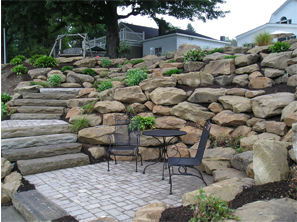 Retaining wall block creates an artistic definition and segregated texture to any landscape or garden. The more beautiful and appropriate to the scene the materials and design of the retaining wall, the higher the quality of ambiance is added to your landscape design.
Retaining wall block creates an artistic definition and segregated texture to any landscape or garden. The more beautiful and appropriate to the scene the materials and design of the retaining wall, the higher the quality of ambiance is added to your landscape design.
There are five primary options when designing for a functional, well-built retaining wall. The first things you should consider before deciding on which retaining wall block you will use are:
a. What type of base does it require; rock, cement block, or gravel
b. Will there be water pressure hitting it, or water swelling around it
c. What type of backfill will be utilized; gravel, wood chips, sand or rock
The Standard Primary Retaining Wall Block Options Include:
1. The Uni-lock Segmented Unit Lock Together Wall Systems
- There are height restrictions that can limit height choice
- They may require special engineering and assembly
- Segmented wall systems have limitations that pose difficulty in certain settings
- Blocks are interlocked with pins, or else might require an adhesive lock to support the strength of the units and wall.
2. Natural Stone
This option lends itself to the most beautiful design options. It is also a very cost effective approach - as dry stacking and hand picking and gathering of your stones is also an option for this method. This approach includes:
- Field Stone Boulders
- Quarry Stone
- Barn Stone
This is the solution that provides the most natural look and feel. It is the approach that works best for landscaping retaining walls on gentle slopes.
The material cost is much lower and dry stacking provides a lowered cost associated with this material. It can also require a professional to install and perform the dry stacking properly, as this is a time tested art form that requires experience.
3. Timber Structure
This approach is quite beautiful because natural wood always provides a warm feel with natural elegance. It is not a good choice if the wall will be consistently damp or wet, or if water pressures will act as a force against the wall.
It is also not advised if you are growing food and other edibles that may transfer the wood treatment or creosote chemicals into the food grown near this wall through water-stimulated seepage over time.
It can be perfect for the flower garden or the lovely sweeping sections of flowers and shrubs that augment the feel of your home and landscape. If your home has a wood exterior, this retaining wall material can augment a landscape with a jaw dropping theme of natural beauty. Remember that with the use of wood retaining walls you will be looking at;
- Treated Pine Material
- Shorter Life, meaning eventually it will rot away
4. Poured Concrete Walls
The poured concrete wall has advantages and disadvantages. It requires more engineering, and structural design. It can demand more materials if you are aiming for a veneer design to support a garden theme. It is very strong and has a reputation of longevity. It will not be prone to pressure movements as stones and wood may be. Some of the biggest considerations for poured concrete include:
- Can have stone veneer applied for custom atheistic look.
- May be used along a lake or pond in many applications
- Has limitations and restrictions for size, shape and cost
- Requires footers and concrete forms for construction
5. The Masonry Retaining Wall Block System
This is another way to integrate stunning design enhancement into your retaining wall project. For the masonry wall you will be looking at:
- Stone
- Brick
- Limitations and restrictions with design options
These walls will require footers with rebar, engineering, and professionally developed architectural designs. Green Impressions: for the best landscaping design, installation and maintenance available.
Author: Joe Schill


